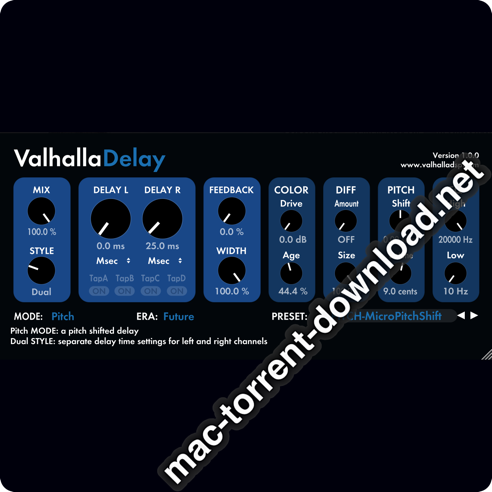Reverb-centered plugins
These plugins are designed primarily to provide reverberation effects.
Valhalla FutureVerb v1.0.2
These plugins are designed primarily to provide reverberation effects.
FutureVerb was designed from the ground up to give you the most transparent and realistic reverbs we’ve ever made. 8 years of research and development have gone into creating new and innovative algorithmic reverb topologies. The FutureVerb reverb modes are as close to perfect as we have ever heard.
And, since we don’t actually believe in perfection, we added a colorful and powerful Echo section that can add color and warmth, or keep things as clean as you wanna be.
With 8 original Reverb modes and 12 flexible Echo modes, FutureVerb gives you the sonic power you need to create your own future.
Valhalla Room v2.0.5
Valhalla Room is a reverb plugin which mainly simulates the acoustics of realistic rooms and halls, although it can also be used for special effects. It has 12 different algorithms. ValhallaDSP says this reverb is best for “idealized room impressions”. One review felt that, while Valhalla Room sounds really good, it sounds more “hyper-real and lush” than “gritty and realistic”. They also felt that its user interface could use some improvement.
Valhalla Vintage Verb v4.0.5
Valhalla Vintage Verb is a plugin with the sounds of various late 1970s and 1980s digital reverberators, including ones which sound like Lexicon and EMT reverbs. This plugin has been used song such as Hello and Water Under the Bridge by Adele, as well as on Lana Del Rey’s album “Lust for Life”. It is possible to change the decay rate of different frequencies, and the early and late diffusion can have separate settings.
The plugin has 20 different algorithms, including:
★ Concert Hall, emulating a “late 1970s and early 1980s” reverb in “hall” mode
★ Plate, emulating an “early 1980s” reverb in “plate” mode
★ Chamber, a “transparent” algorithm described as being “smooth yet dense”
★ Random Space and Smooth Room, which are inspired by or emulate “late 1980s” reverb hardware
★ Sanctuary, which emulates a “a classic German digital reverberator from the 1970s”
★ Nonlin, a modern representation of 1980s gated reverb algorithms
★ Chaotic Neutral, a “colorless” sounding reverberation
ValhallaDSP says this reverb is best for the sound of “old school digital hardware reverbs”. One review feels that while it is excellent for getting the unreal larger than life sound of a classic Lexicon reverb, it does not work as a subtle reverb effect and is not a reverb for every occasion.
Valhalla Plate v1.6.3
Valhalla Plate is a plug in which simulates the sound of a plate reverb or small chamber. It has 12 different algorithms.
ValhallaDSP says this reverb is best for the sound of “warm and dense reverbs of the 1960s and 70s”. Third party reviews of Valhalla Plate have been generally positive, but one review pointed out that “it won’t serve all needs”, since it only simulates plates and small chambers, and does not emulate larger spaces.
Valhalla Supermassive v5.0.0
Valhalla Supermassive is an effect unit which can run various types of delays and reverbs; it is good at, among other things, emulating large spaces. It is a free download.
Delay and sound effect plugins
These plugins provide a combination of delay, sound effect, and reverberation effects.
Valhalla ÜberMod v1.1.6
Valhalla ÜberMod is a plugin which is geared towards delay effects, but can also create reverberant effects.
Valhalla Shimmer v1.2.2
Valhalla Shimmer provides a combination of reverberation and pitch shifting, inspired by the sound of some 1980s Brian Eno and Daniel Lanois collaborations.
Valhalla Freq Echo v1.2.0
Primary a sound effect, the free Valhalla Freq Echo plugin provides a combination of delay and a Bode frequency shifter. This is mainly for making unusual sounds.
Valhalla Space Modulator v1.1.6
Valhalla Space Modulator is a plugin, free with the purchase of any other ValhallaDSP plugin, which simulates some kinds of flanging and pitch shift effects.
Valhalla Delay v3.0.5
Valhalla Delay is a plugin which simulates the sounds of a number of vintage delays, including tape based delays (such as the sound of Roland Space Echo, Maestro Echoplex, or reel to reel based tape delay units), “bucket brigade” delays, 1980s digital delays, and delays with pitch shifting. It features a “ghost” mode which combines delay with frequency shifting. This plugin can do both classic delay sounds and unusual sound effects.
Homepage https://valhalladsp.com
| Name: | ValhallaDSP.bundle.2025.12_Mac-torrents.Net.dmg |
|---|---|
| Size: | 60 MB |
| Files | ValhallaDSP.bundle.2025.12_Mac-torrents.Net.dmg[60 MB] |
